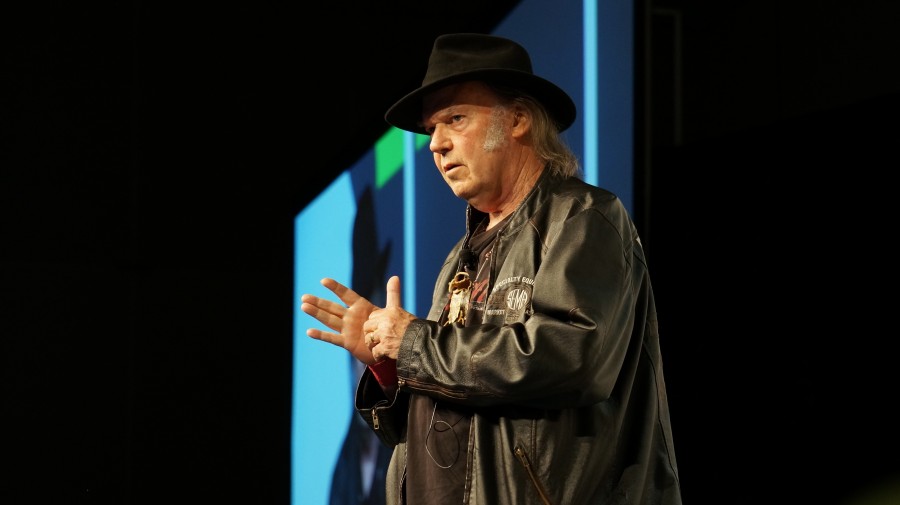Neil Young wants to start a revolution against the MP3, against the CD, poorly made vinyl and poor audio quality in general. He wants people to hear the music the way it was made.
So at SXSW yesterday (and on Kickstarter, which I’ll get to in a moment), Young introduced Pono. In Hawaiian, the word means righteous or goodness. For the world of sound it’s an audio player that Young says he’s been working on for 2 1/2 years, one that’s capable of playing music at the same quality at which it was recorded. (You can listen to his speech via the audio player on this page.)
Right now, most portable players are capable of playing music at about the quality of a CD. In his talk at SXSW, Young pointed out again and again that when music is originally captured in studios, the quality of that recording can be better than a CD. Pono is built around the idea that whatever sound the musician records will be played back on the device without any manipulation. It’s not format specific — MP3s will play on the Pono devices Young’s team is selling, just as the superhigh-quality digital files he speaks so lovingly about.
Below, you can read some of the highlights of Young’s speech, but the whole thing is worth listening to. At the end of the address, he played a video full of testimonials about Pono’s sound by musicians including David Crosby, Sting, Jack White, Beck, Eddie Vedder, Arcade Fire, Gillian Welch, Norah Jones and dozens more. You can see that video here, too — it’s the same one that’s on Pono’s Kickstarter page. That Kickstarter drive had an $800,000 goal when it launched last night. At last check, it already had more than $1.5 million pledged.
Neil Young on Pono
What he sees as the limits of digital music: “I’m a fan of listening loud. I love to listen loud. That’s what it’s all about, really, for me. I love to hear rock ‘n’ roll really loud, and I love to hear even acoustic music really loud. Loud for whatever it is it’s being played on. I like to take whatever it is to the limit, and then listen to it right there. When I started doing that with these machines, it started to hurt, and I couldn’t do it for very long, so the part of the record-making experience that I used to enjoy became painful. That was a sign to me that something was wrong. I complained a little, and I might have bitched and moaned a little about that, too. Then time went by, and I got some better machines, but they weren’t really that much better — it didn’t change it. But I noticed when I listened to CDs in my car, the same thing happened — it hurt my ears a little bit. And then the MP3 came along, and that’s when the recording industry really went into duress.”
Why he thinks high-quality reproductions are important: “Whatever you believe about where things come from, the human body is unbelievable. It’s so sensitive. And when you give it something, it loves it. You give it good food, it grows. It’s nourished. And when you give it good input, it loves it. When it sees great art, it feels good. We all are like that. So with our music, we were deprived. And we started getting very little, a minuscule 1/20th of what we [are] capable of getting, what we used to listen to. So then one or two listenings, you’d heard it. Your body was not getting anything new after that. You’ve already figured it out. That’s it. OK, I recognize it. And music even changed a little bit. … Music adapted. It became beat-heavy and it became right for what the media was that was selling it. It became smart, it became clever, tricky.”
One reason he was frustrated by the rise of the MP3: “I love making records. That’s what I do. I love every song on the record, I love every note on every song on every record. They meant something to me. They’re a family of songs that were telling a story of how I was feeling. They weren’t just filler. I’m not the only one who feels this way.”
How Pono was conceived: “You’re all listening to a lot of MP3s. They’re very convenient. So what we decided to do was come out with a new system that was not a format, had no rules, respected the arc, respected what the artist was trying to do and did everything that it could to give you what the artist gave, so that you get to feel not just what the artist intended you to feel, but actually what the artist did. And that is what Pono is. Pono plays back whatever the artist decided to do or the artist’s producer decided to do.”
How he hopes the audiophile world responds to Pono: “All those big things that you had to give away or put in the garage, they can come back now. All those stereo stores that had to close because there’s no reason for big speakers anymore because people listen to little things that look like lozenges? Because those are the new sound? How cool they could be? You can put it right on the kitchen table next to the toaster and it sounds exactly like an MP3. Now maybe those stores will start to open up again.”
9(MDAxNzk1MDc4MDEyMTU0NTY4ODBlNmE3Yw001))


